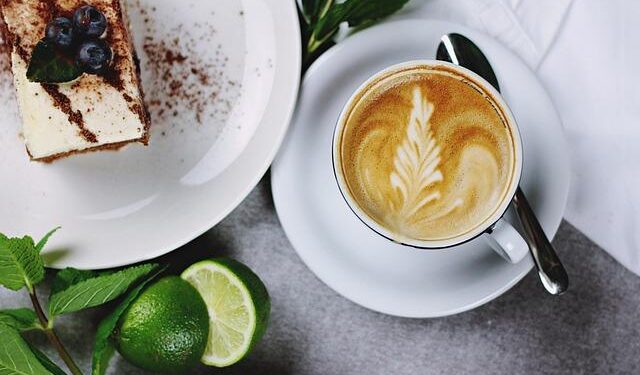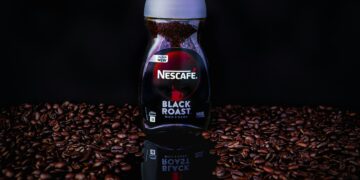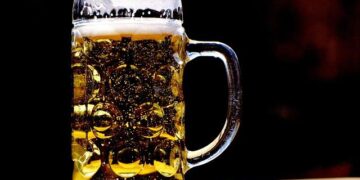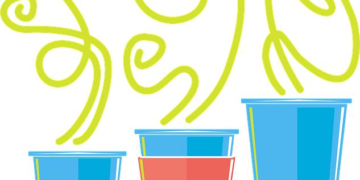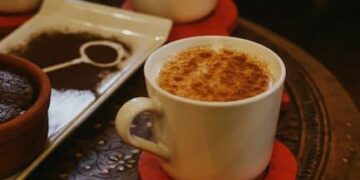Table of Contents
It is a familiar scene, played out daily in cities and suburbs across the globe.
The clock strikes 3 P.M., and with it comes the predictable dip in energy, a mental fog that settles in and calls for a remedy.
For millions, the answer is a ritualistic trip to a cafe, often one marked by a globally recognized green siren.
The craving is specific: something cold, sweet, and restorative.
The order is placed for a Frappuccino, perhaps a classic Caramel or Mocha, a nostalgic treat that feels more like a dessert than a simple coffee.
As the first icy, sweet sip is taken, a question may surface, often fleeting and unexamined: how much of a caffeine kick does this beloved beverage actually provide?
This seemingly simple question is the gateway to a surprisingly complex world.
The Starbucks Frappuccino, a cultural touchstone and a pillar of the modern coffee shop menu, is a product consumed on a massive scale, yet it remains widely misunderstood.
It exists in a category of its own, straddling the line between coffee, milkshake, and afternoon indulgence.
Its identity is fluid, its composition a carefully guarded piece of beverage engineering.
What follows is a deep-dive investigation, a journey from the perspective of a casual consumer to that of an informed expert, designed to unravel the Frappuccino enigma.
This report will dissect the menu, analyze the ingredients, and contextualize the caffeine content to provide a definitive guide for the conscious consumer.
The journey begins with a single order but ends with a complete understanding of what truly lies beneath the whipped cream.
Chapter 1: Decoding the Menu – The Fundamental Divide Between Coffee and Crème
The first step in any investigation is to survey the scene.
At Starbucks, this means confronting the menu board—a glowing tapestry of options that can be both enticing and overwhelming.
A close examination of the Frappuccino section reveals the first critical clue, a fundamental division that forms the bedrock of this entire analysis: Frappuccinos are not a monolith.
They are split into two distinct and separate families: “Coffee Frappuccinos” and “Crème Frappuccinos”.1
This distinction is not merely a matter of flavor; it is a statement of core composition.
The “Coffee” designation signifies that the beverage is built with a coffee-based foundation, designed to deliver a dose of caffeine.
Conversely, the “Crème” line uses a coffee-free base, creating a beverage that is, by default, a caffeine-free treat.3
This immediately challenges the pervasive assumption that all Frappuccinos are, at their heart, blended coffee drinks.
The name “Frappuccino” functions as a broad marketing umbrella for a
style of beverage—blended, iced, and sweet—rather than a specific type of beverage.
For the consumer, the choice between a Caramel Frappuccino and a Vanilla Bean Crème Frappuccino is not just a preference of taste but a functional decision between a caffeinated boost and a non-caffeinated indulgence.
To quantify this divide, one must turn to the official nutritional data.
For a standard Grande (16 fl oz) serving, the numbers are clear and consistent.
The flagship Coffee Frappuccino contains 95 mg of caffeine, a respectable amount for a mid-day lift.5
The ever-popular Caramel Frappuccino follows closely with 90 mg of caffeine.6
Other mainstays in the coffee family, such as the Mocha and Java Chip Frappuccinos, hover in a similar range, typically containing between 100 mg and 110 mg of caffeine, respectively.7
In stark contrast, the Crème family presents a completely different profile.
The Vanilla Bean Crème Frappuccino, a favorite for its simple, sweet flavor, contains precisely 0 mg of caffeine.9
The same is true for the fruit-forward Strawberries & Crème Frappuccino, which also registers at 0 mg of caffeine, making it a popular choice for children or those avoiding stimulants altogether.10
This initial data creates a clear picture, best summarized in a comparative table.
| Frappuccino Flavor | Category | Caffeine Content (mg) | Source(s) |
| Coffee Frappuccino | Coffee | 95 | 5 |
| Caramel Frappuccino | Coffee | 90 | 6 |
| Mocha Frappuccino | Coffee | 110 | 7 |
| Java Chip Frappuccino | Coffee | 110 | 7 |
| Vanilla Bean Crème Frappuccino | Crème | 0 | 9 |
| Strawberries & Crème Frappuccino | Crème | 0 | 10 |
Table 1: Caffeine at a Glance: A Snapshot of In-Store Frappuccinos (Grande, 16 oz)
This table provides an essential orientation.
It visually confirms the foundational insight of this chapter: the Frappuccino category is bifurcated.
The choice a consumer makes at the counter has significant, if not immediately obvious, implications for their caffeine intake.
This discovery, however, only scratches the surface of the enigma.
The investigation must now move beyond the cafe and into the brightly lit aisles of the grocery store, where another layer of complexity awaits.
Chapter 2: The Grocery Aisle Anomaly – The Bottled Frappuccino Paradox
The investigation expands as a familiar product is spotted in an unfamiliar setting: the refrigerated section of a supermarket.
There, nestled among juices and iced teas, sits the glass-bottled Starbucks Frappuccino.
It is a product many assume to be a simple, shelf-stable version of its in-store cousin, a convenient grab-and-go option for when a trip to the cafe is not possible.
This assumption, however, is deeply flawed.
A closer look at the product, its manufacturing, and its nutritional label reveals a surprising paradox: the bottled Frappuccino is a fundamentally different beverage with a significantly more potent caffeine delivery.
The first clue lies in its production.
While in-store Frappuccinos are handcrafted by baristas, the ready-to-drink (RTD) bottled versions are the result of a long-standing partnership between Starbucks and PepsiCo.13
This distinction is crucial, as the demands of mass production and shelf stability necessitate a different formulation than a drink made to be consumed within minutes.
This difference in formulation becomes starkly evident when comparing the caffeine content.
The bottled Frappuccinos are most commonly sold in two sizes: a 9.5 fl oz bottle and a larger 13.7 fl oz bottle.
The caffeine content varies by flavor and, in some cases, by size.
For the standard 9.5 oz bottle, the Coffee flavor contains a formidable 130 mg of caffeine, while the Mocha flavor has 110 mg, Caramel has 90 mg, and Vanilla has 75 mg.12
The larger 13.7 oz bottles often contain around 110 mg of caffeine across various flavors like Coffee, Mocha, and Caramel.13
The true anomaly, or paradox, is revealed not by looking at these numbers in isolation, but by placing them in direct comparison with their in-store counterparts.
Consider the Caramel Frappuccino.
An in-store Grande is a 16 fl oz beverage containing 90 mg of caffeine.6
The bottled version, in its smaller 9.5 fl oz format, contains the
exact same 90 mg of caffeine.12
The consumer receives the same total caffeine dose from a beverage that is little more than half the size.
This is not a minor variation; it points to a significant difference in the beverage’s concentration.
To quantify this, one must calculate the caffeine density, or the amount of caffeine per fluid ounce.
- In-Store Grande Caramel Frappuccino (16 oz): 90 mg/16 fl oz=5.6 mg/oz
- Bottled Caramel Frappuccino (9.5 oz): 90 mg/9.5 fl oz=9.5 mg/oz
The calculation confirms the paradox: the bottled version is nearly 70% more concentrated in terms of caffeine.
A consumer who drinks a bottled Frappuccino believing it to be a “smaller” version of the cafe drink is inadvertently consuming a much more potent dose of caffeine on a per-ounce basis.
This is a critical piece of information for anyone tracking their daily intake for health, wellness, or medical reasons.
The likely reason for this disparity is rooted in the manufacturing process; the need for a shelf-stable formula, developed by PepsiCo, requires a different ratio of ingredients, including a more powerful coffee extract, to achieve the desired flavor profile in a smaller, sealed container.
The following table lays out this “tale of two Frappuccinos,” making the hidden story of concentration undeniably clear.
| Flavor | Format | Volume (fl oz) | Total Caffeine (mg) | Caffeine per oz (mg/oz) |
| Coffee | In-Store Grande | 16 | 95 | 5.9 |
| Bottled | 9.5 | 130 | 13.7 | |
| Bottled | 13.7 | 110 | 8.0 | |
| Caramel | In-Store Grande | 16 | 90 | 5.6 |
| Bottled | 9.5 | 90 | 9.5 | |
| Bottled | 13.7 | 110 | 8.0 | |
| Mocha | In-Store Grande | 16 | 110* | 6.9* |
| Bottled | 9.5 | 110 | 11.6 | |
| Bottled | 13.7 | 110 | 8.0 | |
| Vanilla | In-Store Crème | 16 | 0 | 0.0 |
| Bottled | 9.5 | 75 | 7.9 |
*Table 2: In-Store vs. Bottled: A Tale of Two Frappuccinos (Note: In-store Mocha caffeine is an average from multiple sources; bottled Vanilla is caffeinated while its in-store Crème counterpart is not).
This table serves as the evidentiary centerpiece of the chapter.
The “Caffeine per oz” column normalizes the data, allowing for a true, apples-to-apples comparison and proving that the bottled and in-store drinks are far from interchangeable.
The investigation has now established what the caffeine content is and where it differs.
The next logical question is how it gets there in the first place.
Chapter 3: The Engine Room – Unmasking “Frap Roast” and the Role of Espresso
The journey now moves from the consumer-facing menu to the inner workings of the barista station—the “engine room” where these iconic drinks are made.
A common mental image of a Frappuccino’s creation involves a barista pulling steaming shots of espresso and blending them with milk, syrup, and i.e. This image, however, is largely incorrect.
The quest to understand the source of a Frappuccino’s caffeine leads to the discovery of a specialized, proprietary ingredient that is key to the beverage’s very existence: Frap Roast.
Digging through online forums and discussions populated by current and former Starbucks baristas reveals a crucial piece of insider knowledge.
The vast majority of Coffee Frappuccinos are not made with the same espresso used in lattes and macchiatos.
Instead, they are made with “Frap Roast,” a unique, unsweetened instant coffee powder developed specifically for this purpose.2
It is described by those who use it as a “super concentrated coffee” designed to dissolve instantly in cold liquids, providing coffee flavor and caffeine without disrupting the drink’s carefully engineered texture.15
The standard recipe is built around pumps of this powder, which is reconstituted with water into a liquid concentrate.
A Tall (12 oz) Frappuccino receives two pumps, a Grande (16 oz) gets three, and a Venti (24 oz) gets four.15
Barista accounts suggest that a single pump of this Frap Roast concentrate contains approximately 35 mg of caffeine.15
This aligns neatly with the official data: three pumps in a Grande would yield about 105 mg, which is very close to the 95-110 mg range seen in the most popular Coffee Frappuccino varieties.
This stands in sharp contrast to a standard Starbucks espresso shot, which consistently contains 75 mg of caffeine.7
The reason for this divergence is not about flavor or cost, but about beverage physics.
As baristas explain, adding multiple shots of hot espresso to the blender would melt the ice, destroying the thick, smooth, and stable consistency that is the hallmark of a Frappuccino.
The result would be a “soupy mess,” a disappointing and watery drink.15
Therefore, the physical requirement for that signature texture is the primary driver of the Frappuccino’s unique caffeine delivery system.
It necessitated the invention of a specialized, cold-soluble coffee ingredient, setting the Frappuccino platform entirely apart from the espresso-based and brewed-coffee platforms at Starbucks.
This understanding also clarifies customization.
A customer seeking extra caffeine in their Frappuccino would be better served asking for an “extra pump of Frap Roast” rather than adding an espresso shot, as the former boosts caffeine without compromising the drink’s integrity.15
There is, however, one key exception that proves this rule: the Espresso Frappuccino.
A casual consumer might assume this drink replaces the Frap Roast with espresso.
In reality, it is an additive construction.
The Espresso Frappuccino is made with the standard base of Frap Roast plus a shot of espresso poured on top.7
This combination makes it the most potent standard offering in the Frappuccino line.
A Grande Espresso Frappuccino contains approximately 155-165 mg of caffeine (a baseline of ~95 mg from the Frap Roast plus 75 mg from the espresso shot).7
This makes the name “Espresso Frappuccino” a signal of additional caffeine, a stealthy high-caffeine choice that surpasses even a Grande Caffè Latte (150 mg).
It is a critical distinction for a consumer looking for a serious energy boost.
Chapter 4: The Hidden Contributors – Uncovering Covert Caffeine in Crème
Just as a clear map of the Frappuccino landscape seems complete, a few anomalies emerge that demand closer inspection.
The neat binary established in the first chapter—Coffee Frappuccinos have caffeine, Crème Frappuccinos do not—begins to fray at the edges.
A deeper look into the ingredient lists of certain Crème-based drinks reveals that the absence of coffee does not always mean the absence of caffeine.
This chapter delves into the world of these “hidden” or “covert” contributors, hunting for caffeine in sources other than coffee.
The first and most common source is chocolate.
Both the mocha sauce and the “java chips” (which are simply chocolate chips) used in many Starbucks beverages are derived from cocoa beans.
Cocoa is a natural source of caffeine, and any product containing it will carry a small amount of the stimulant.20
To isolate and quantify this contribution, the Starbucks Hot Chocolate serves as a perfect proxy.
A Grande Hot Chocolate, which is primarily composed of steamed milk and mocha sauce, contains 25 mg of caffeine.22
This fact directly explains the caffeine content of the Double Chocolaty Chip Crème Frappuccino.
Despite being a member of the “Crème” family and containing no Frap Roast, it is not caffeine-free.
A Grande size contains 15 mg of caffeine, a modest but non-zero amount derived entirely from its chocolate ingredients (mocha sauce and chips).4
A far more significant hidden contributor is matcha.
The Matcha Crème Frappuccino is another member of the coffee-free Crème family, but its caffeine content is substantial.
This is because matcha is not merely a flavoring; it is a fine powder made from whole, ground green tea leaves, which are naturally caffeinated.24
Consuming matcha means consuming the entire leaf, resulting in a higher concentration of both antioxidants and caffeine compared to simply steeping green tea.24
The numbers are striking.
A Grande Matcha Crème Frappuccino contains between 65 mg and 80 mg of caffeine, depending on the data source.19
This is a significant dose, roughly equivalent to a shot of espresso or a Red Bull energy drink.
This finding fundamentally redefines the “Crème” category.
It becomes clear that “Crème” signifies only the absence of
coffee (Frap Roast or espresso), not the absence of caffeine.
This is a crucial distinction for any caffeine-conscious consumer.
A parent purchasing a treat for a child, a pregnant person carefully monitoring their intake, or an individual with high caffeine sensitivity could be easily misled by the menu’s categorization.
A Grande Matcha Crème Frappuccino contains more than double the caffeine of a can of Coca-Cola, a fact that is not at all apparent from its “Crème” designation.
Furthermore, the type of caffeine in matcha introduces another layer of nuance.
Matcha is unique in that it contains a high concentration of L-theanine, an amino acid known to promote a state of calm alertness.24
This compound works synergistically with caffeine, modulating its effects to produce a smoother, more sustained energy boost without the “jitters” or anxiety that can sometimes accompany a strong cup of coffee.25
Therefore, while a Grande Matcha Crème Frappuccino (at ~80 mg) and a bottled Vanilla Frappuccino (at 75 mg) have nearly identical amounts of caffeine, the subjective physiological experience may be quite different.
This demonstrates that a simple milligram count does not tell the whole story; the source of the caffeine and its accompanying biochemical compounds can significantly alter its effect on the body.
Chapter 5: Establishing a Baseline – The Frappuccino in a Caffeinated World
The investigation has now yielded a wealth of data: caffeine amounts have been quantified, ingredients have been unmasked, and hidden sources have been revealed.
But these numbers exist in a vacuum.
What does “95 mg of caffeine” truly mean in the context of a daily diet? Is it a little or a lot? To answer this, the Frappuccino must be placed within the broader ecosystem of caffeinated beverages.
By building a “Caffeine Ladder,” it is possible to establish a clear baseline and understand where this iconic drink stands in the grand scheme of things.
The Grande Coffee Frappuccino, with its 95 mg of caffeine, serves as an ideal benchmark for this comparison.5
The first step is to see how it stacks up against other popular Grande-sized offerings within Starbucks itself.
This internal hierarchy reveals some counterintuitive truths.
- A Grande Caffè Latte, a seemingly milder, milk-heavy drink, contains 150 mg of caffeine, over 50% more than the Frappuccino. This is because it is made with two standard espresso shots (75 mg each).19
- A Grande Iced Coffee (sweetened) contains 165 mg of caffeine.19
- Most surprisingly, the simple brewed coffees are the true caffeine powerhouses on the menu. A Grande Pike Place Roast contains a massive 310 mg of caffeine.19
- The Grande Blonde Roast, a lighter-tasting brew, is even more potent, delivering an astonishing 360 mg of caffeine.19
This internal comparison alone is illuminating.
It shows that the Frappuccino, often perceived as a potent, sugary coffee drink, actually sits on the lower end of the caffeine spectrum for Starbucks’ coffee-based beverages.
A customer would need to drink more than three Grande Coffee Frappuccinos to equal the caffeine in a single Grande Pike Place Roast.
The next step is to broaden the comparison to the wider market of common caffeinated products.
This provides real-world context for consumers making daily choices.
- A 12 oz can of Coca-Cola contains approximately 34 mg of caffeine.28
- A 12 oz can of Pepsi is slightly higher at around 38 mg.28
- An 8.4 oz can of Red Bull contains 80 mg of caffeine, placing it just below the Coffee Frappuccino.29
- A standard 8 oz cup of home-brewed coffee is estimated to contain about 95 mg of caffeine, making it almost identical to the Grande Coffee Frappuccino.12
- A 16 oz can of Monster Energy drink contains about 160 mg of caffeine, putting it on par with a Starbucks Latte or Iced Coffee.30
The combined data can be visualized as a ladder, providing an immediate and intuitive understanding of where the Frappuccino fits.
| Beverage | Serving Size (fl oz) | Caffeine (mg) |
| Coca-Cola | 12 | 34 |
| Pepsi | 12 | 38 |
| Red Bull | 8.4 | 80 |
| Grande Coffee Frappuccino | 16 | 95 |
| Home-Brewed Coffee | 8 | 95 |
| Grande Caffè Latte | 16 | 150 |
| Monster Energy | 16 | 160 |
| Grande Iced Coffee | 16 | 165 |
| Grande Pike Place Roast | 16 | 310 |
| Grande Blonde Roast | 16 | 360 |
Table 3: The Caffeine Ladder: Where Does a Frappuccino Stand?
The conclusion drawn from this ladder is clear and powerful.
The standard Coffee Frappuccino is a moderate caffeine beverage.
Its potency is roughly equivalent to a standard cup of home-brewed coffee or a small energy drink, and it is significantly less caffeinated than most other coffee drinks on the Starbucks menu.
The most significant revelation is that the strongest caffeine doses at Starbucks come not from complex, multi-ingredient blended or espresso drinks, but from the humble, unassuming cup of brewed coffee.
This insight reframes the entire menu, empowering consumers to look past marketing perceptions and make choices based on data.
Chapter 6: The Conscious Consumer’s Guide – Navigating Your Order and Your Limits
The journey of investigation, which began with a simple craving, has now yielded a comprehensive map of the Frappuccino’s caffeinated landscape.
The final and most crucial step is to translate this complex data into a practical, actionable guide.
Armed with this knowledge, any consumer can navigate the Starbucks menu with precision and confidence, tailoring their order to their exact caffeine needs and preferences.
Effective caffeine management at Starbucks requires learning the “language” of the menu’s construction, as the surface-level categories can be ambiguous.
Here is a clear guide based on the insights gathered:
How to Order for Your Specific Caffeine Needs
- For Zero Caffeine: The most straightforward approach is to order a true Crème Frappuccino that does not contain chocolate or matcha. The Vanilla Bean Crème Frappuccino and the Strawberries & Crème Frappuccino are guaranteed to be 0 mg caffeine choices.9 One can also request any other flavor be made with the crème base, provided it doesn’t involve a naturally caffeinated syrup or powder.
- For Minimal Caffeine (A Hint of a Buzz): For those who want a dessert-like drink with just a tiny lift, a Crème-based Frappuccino that includes chocolate is the ideal choice. The Double Chocolaty Chip Crème Frappuccino provides a gentle 15 mg of caffeine from its mocha sauce and chocolate chips.4
- For the Flavor of Coffee Without the Full Kick (The “Insider” Decaf Order): This requires speaking the barista’s language. Standard decaf coffee is not an ingredient in Frappuccinos. To achieve this, one must request a specific substitution. The correct way to order is: “I would like a [Caramel] Frappuccino, but please substitute the Frap Roast with decaf espresso shots”.33 For a Grande, this would typically mean two decaf shots. Since a decaf espresso shot contains only a trace amount of caffeine (typically 5-15 mg), this order delivers the desired coffee flavor with a total caffeine content of only about 10-30 mg, a significant reduction from the standard 90-110 mg.34
Placing Frappuccinos Within Health Guidelines
Understanding the numbers is only half the battle; contextualizing them against established health recommendations is what makes the knowledge truly powerful.
- For Healthy Adults: The U.S. Food and Drug Administration (FDA) cites up to 400 mg of caffeine per day as an amount not generally associated with negative effects for most healthy adults.35 Within this framework, most Frappuccinos fit comfortably. A Grande Coffee Frappuccino (95 mg) uses less than a quarter of this daily allowance. Even a Venti (125 mg) is a moderate choice.19 However, this context also highlights the potency of other Starbucks drinks; a single Venti Blonde Roast (475 mg) exceeds the entire recommended daily limit.19
- For Pregnant Individuals: The American College of Obstetricians and Gynecologists (ACOG) recommends that pregnant individuals limit their caffeine intake to less than 200 mg per day.37 This makes a Grande Coffee Frappuccino (95 mg) a viable option that consumes about half of the daily budget. A Grande Matcha Crème Frappuccino (~80 mg) is similarly acceptable. However, a Grande Caffè Latte (150 mg) uses up 75% of the recommended daily allowance, making it a choice that requires more careful planning for the rest of the day. This practical application of the data is invaluable for this specific demographic.
Debunking Common Caffeine Myths
The investigation also serves to dismantle several persistent myths about caffeine that can lead to misguided consumer choices.
- Myth: Darker roast coffee has more caffeine.
- Fact: The roasting process burns off a small amount of caffeine. Therefore, lighter roasts, like Starbucks’ Blonde Roast, are generally more caffeinated than dark roasts.17 The “strong” taste of a dark roast is due to its flavor profile, not its caffeine content.
- Myth: Espresso is the “strongest” form of coffee.
- Fact: Espresso is the most concentrated form of coffee in terms of caffeine per ounce. A one-ounce shot has 75 mg.40 However, a large cup of brewed coffee contains a much higher
total dose of caffeine. A 16 oz Grande Pike Place Roast has 310 mg of caffeine, more than four times the amount in a single espresso shot.19 - Myth: Decaf means zero caffeine.
- Fact: The decaffeination process removes about 97% of the caffeine, but not all of it. A cup of decaf coffee or a decaf espresso shot still contains trace amounts of caffeine, typically ranging from 2 mg to 15 mg.21 While negligible for most, this can be relevant for individuals with extreme sensitivity.
Conclusion: A New Perspective on an Old Favorite
The journey that began with a single, idle question during a mid-afternoon energy slump has culminated in a comprehensive deconstruction of a modern beverage icon.
The Frappuccino, once viewed as a simple, monolithic treat, is now revealed to be a complex and varied product line, engineered with precision and marketed with savvy.
The investigation has peeled back the layers of the enigma.
It has exposed the fundamental divide between the caffeinated “Coffee” family and the often-but-not-always caffeine-free “Crème” family.
It has uncovered the paradox of the bottled Frappuccino, a product far more potent in its caffeine concentration than its in-store namesake.
The curtain has been pulled back on the “engine room,” revealing Frap Roast as the purpose-built heart of the drink, a component born from the demands of beverage physics.
The detective work has identified the covert caffeine contributors in chocolate and matcha, complicating the simple menu categories.
Finally, by placing the Frappuccino on a comparative ladder, its true standing in the caffeinated world—as a moderate, mid-tier option—has been firmly established.
This deeper knowledge does not spoil the magic of a beloved treat; it enhances it.
Understanding the intricate details of a Frappuccino’s composition transforms the act of consumption from a passive habit into a mindful, personalized choice.
The power is shifted back to the consumer, who is no longer navigating the menu based on flavor names and assumptions, but on a solid foundation of data.
The enigma is solved.
The next time the 3 P.M. craving hits, the choice will be made not out of habit, but with a newfound sense of clarity, confidence, and control.
Works cited
- How Much Caffeine Is In A Starbucks Frappuccino? – Chowhound, accessed August 4, 2025, https://www.chowhound.com/1719539/how-much-caffeine-starbucks-frappuccino/
- What are the differences between Creme Frappuccinos and regular Frappuccinos? – Reddit, accessed August 4, 2025, https://www.reddit.com/r/starbucks/comments/3aez04/what_are_the_differences_between_creme/
- What is the Difference Between a Frappe and a Frappuccino? – OutIn, accessed August 4, 2025, https://outin.com/blogs/news/frappe-vs-frappuccino-difference
- Here’s how much caffeine is in a Starbucks Frappuccino – Cliff & Pebble, accessed August 4, 2025, https://cliffandpebble.com/blogs/our-blog/do-starbucks-frappuccinos-have-caffeine
- Coffee Frappuccino® Blended Beverage: Nutrition: Starbucks …, accessed August 4, 2025, https://www.starbucks.com/menu/product/483/iced/nutrition
- Caramel Frappuccino® Blended Beverage: Nutrition: Starbucks …, accessed August 4, 2025, https://www.starbucks.com/menu/product/424/iced/nutrition
- Starbucks Caffeine: 24 Drinks Ranked by Caffeine Content | Corner Coffee Store, accessed August 4, 2025, https://cornercoffeestore.com/starbucks-caffeine-guide/
- Starbucks Java Chip Frappuccino Blended Beverage – a true love/hate relationship, accessed August 4, 2025, https://sweetsreporter.com/2013/09/23/starbucks-java-chip-frappuccino-blended-beverage-a-true-lovehate-relationship/
- Vanilla Bean Crème Frappuccino® Blended Crème: Nutrition: Starbucks Coffee Company, accessed August 4, 2025, https://www.starbucks.com/menu/product/440/iced/nutrition
- Skinny Starbucks Strawberries and Cream Frappuccino – Delightful E Made, accessed August 4, 2025, https://delightfulemade.com/skinny-starbucks-strawberries-and-cream-frappuccino/
- Starbucks strawberry crème frappucino – The Chat Board – The Well Trained Mind Forum, accessed August 4, 2025, https://forums.welltrainedmind.com/topic/740791-starbucks-strawberry-cr%C3%A8me-frappucino/
- How Much Caffeine Is in Starbucks Bottled Frappuccinos? 2025 Breakdown | Corner Coffee Store, accessed August 4, 2025, https://cornercoffeestore.com/how-much-caffeine-in-starbucks-bottled-frappuccinos/
- Starbucks Frappuccino – Coffee – 13.7 fl oz – PepsiCo Product Facts, accessed August 4, 2025, https://www.pepsicoproductfacts.com/Home/Product?formula=STARFRAP_CO&form=RTD&size=13.7
- FRAPPUCCINO | STARBUCKS® | PEPSICO BRANDS, accessed August 4, 2025, https://www.pepsicopartners.com/pepsico/en/USD/PEPSICO-BRANDS/STARBUCKS%C2%AE/FRAPPUCCINO/c/brand_starbucks_subbrand_frappuccino?root=beverages&fromSubbrand=Y&showProductListing=true
- Is this the equivalent of 8 espresso shots? How much caffeine is in a pump of frap sauce? : r/starbucks – Reddit, accessed August 4, 2025, https://www.reddit.com/r/starbucks/comments/4eh0gp/is_this_the_equivalent_of_8_espresso_shots_how/
- Frappuccino roast vs espresso : r/starbucks – Reddit, accessed August 4, 2025, https://www.reddit.com/r/starbucks/comments/wdskci/frappuccino_roast_vs_espresso/
- Starbucks: Coffee vs. Espresso – YouTube, accessed August 4, 2025, https://www.youtube.com/watch?v=-zLL3A9Qryg
- The Unique Powdered Coffee Starbucks Uses For Frappuccinos – Tasting Table, accessed August 4, 2025, https://www.tastingtable.com/1850172/starbucks-frappuccino-roast-powder/
- How Much Caffeine in a Cup of Starbucks Coffee? – CAFELY, accessed August 4, 2025, https://cafely.com/blogs/info/how-much-caffeine-starbucks-coffee
- How Much Caffeine In Hot Chocolate, accessed August 4, 2025, https://www.hillcountrychocolate.com/blogs/chocolate-and-confections-1/how-much-caffeine-in-hot-chocolate
- 6 Surprising Foods with Caffeine—and What to Do When You’ve Had Too Much, accessed August 4, 2025, https://health.umms.org/2023/12/21/surprising-foods-with-caffeine/
- Starbucks Hot Chocolate Price, Calories & Ingredients 2025, accessed August 4, 2025, https://starbucks-menus.com/starbucks-hot-chocolate/
- Hot Chocolate: Nutrition: Starbucks Coffee Company, accessed August 4, 2025, https://www.starbucks.com/menu/product/471/hot/nutrition
- Does Starbucks Matcha Have Caffeine? – Foodzilla, accessed August 4, 2025, https://foodzilla.com/questions/does-starbucks-matcha-have-caffeine
- Does Starbucks Matcha Have Caffeine In It? – Tasting Table, accessed August 4, 2025, https://www.tastingtable.com/1792676/starbucks-matcha-caffeine-content/
- Starbucks Caffe Latte Price, Nutrition & Ingredients, accessed August 4, 2025, https://starbucks-menus.com/starbucks-caffe-latte/
- Caffeine content for various drinks in ascending order : r/starbucks – Reddit, accessed August 4, 2025, https://www.reddit.com/r/starbucks/comments/7e9q7w/caffeine_content_for_various_drinks_in_ascending/
- How Much Caffeine Is In Coffee vs Tea vs Soda, accessed August 4, 2025, https://coffeebros.com/blogs/coffee/how-much-caffeine-is-in-coffee-vs-tea-vs-soda
- Caffeine Content for some of the Most Popular Drinks Revealed – ViDrate, accessed August 4, 2025, https://www.vidrate.com/blogs/news/caffeine-content-for-some-of-the-most-popular-drinks-revealed
- Red Bull vs. Monster: What’s the Difference? – Healthline, accessed August 4, 2025, https://www.healthline.com/nutrition/red-bull-vs-monster
- Caffeine Myths and Facts – WebMD, accessed August 4, 2025, https://www.webmd.com/diet/caffeine-myths-and-facts
- cafely.com, accessed August 4, 2025, https://cafely.com/blogs/info/caffeine-in-red-bull#:~:text=Monster%20Energy%20has%20166%20mg,in%20terms%20of%20caffeine%20content.
- How do I order a decaf Frappuccino correctly? : r/starbucks – Reddit, accessed August 4, 2025, https://www.reddit.com/r/starbucks/comments/1cgubrx/how_do_i_order_a_decaf_frappuccino_correctly/
- low caffeine recommendations? : r/starbucks – Reddit, accessed August 4, 2025, https://www.reddit.com/r/starbucks/comments/1hmu6kc/low_caffeine_recommendations/
- www.fda.gov, accessed August 4, 2025, https://www.fda.gov/consumers/consumer-updates/spilling-beans-how-much-caffeine-too-much
- Is caffeine a friend or foe? – American Heart Association, accessed August 4, 2025, https://www.heart.org/en/news/2022/08/08/is-caffeine-a-friend-or-foe
- ACOG: Moderate Caffeine Consumption Does Not Cause Miscarriage, Preterm Birth, accessed August 4, 2025, https://www.jwatch.org/fw201007230000001/2010/07/23/acog-moderate-caffeine-consumption-does-not
- Caffeine During Pregnancy – NorthShore, accessed August 4, 2025, https://www.northshore.org/healthresources/encyclopedia/encyclopedia.aspx?DocumentHwid=tn7380
- Busting Common Coffee Myths: The Truth Behind Your Favorite Brew, accessed August 4, 2025, https://www.nashhousesaloon.com/posts/busting-common-coffee-myths-the-truth-behind-your-favorite-brew
- That’s a fair point, Starbucks coffee has more caffeine than an average cup of c… – Hacker News, accessed August 4, 2025, https://news.ycombinator.com/item?id=26613004
- Pictures: Surprising Sources of Caffeine – WebMD, accessed August 4, 2025, https://www.webmd.com/diet/ss/slideshow-how-much-caffeine
